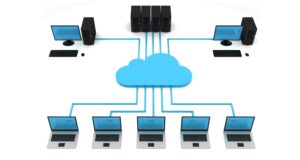Table of Contents
- What Is Cloud Security?
- Cloud Security Is A Shared Responsibility
- The 6 Pillars of Secure Cloud Services
What Is Cloud Security?
Cloud computing is the Internet-based delivery of hosted services, such as software, hardware, and storage. Cloud computing has become essentially ubiquitous among enterprises of all sizes, often as part of a hybrid/multi-cloud IT design due to the advantages of quick deployment, flexibility, minimal up-front costs, and scalability.
Cloud security is a broad term that encompasses the technology, policies, procedures, and services that safeguard cloud data, applications, and infrastructure from attacks.
Cloud Security Is A Shared Responsibility
Security in the cloud is a joint duty between the cloud provider and the client. The Shared Responsibility Model divides obligations into three categories: those that are always the provider’s, those that are always the customer’s, and those that change according to the service model: Cloud email is a kind of infrastructure as a service (IaaS), platform as a service (PaaS), or software as a service (SaaS).
The provider’s security duties always include securing the infrastructure itself and granting access to, patching, and configuring the physical hosts and physical network on which the compute instances operate. The storage and other resources are located.
The customer is always responsible for security. This includes managing users and their access rights, protecting cloud accounts from unwanted access, encrypting and protecting cloud-based data assets, and maintaining the customer’s security posture.
The 6 Pillars of Secure Cloud Services
While cloud providers such as Google Cloud Platform (GCP), Microsoft Azure (Azure), and Amazon Web Services (AWS) offer numerous cloud-native security features and services, enterprise-grade cloud workload protection from breaches, data leaks, and targeted attacks in the cloud environment requires supplementary third-party solutions. Only an integrated cloud-native/third-party security stack delivers the centralized visibility and granular policy-based management required to implement the following industry best practices:
Granular IAM And Authentication Policies For Complicated Infrastructures
Utilize groups and roles to simplify the process of updating IAM definitions. Grant just the minimum access rights necessary for a group or role to perform its functions. The broader the privileges, the higher the authentication tiers. Keep in mind basic IAM hygiene, such as implementing strong password policies and authorization time-outs.
Securing Logically Separated Networks And Micro-Segments In The Cloud
Deploy mission-critical resources and applications in logically isolated areas of the cloud provider’s network, such as Virtual Private Clouds (AWS and Google) or virtual networks (vNETs) (Azure). Utilize subnets to isolate workloads using granular security controls at subnet gateways. Utilize dedicated WAN lines and static user-defined routing settings to tailor access to virtual devices, networks and gateways, and public IP addresses in hybrid systems.
Monitoring And Enforcing Virtual Server Security Rules And Procedures
Cloud security suppliers offer strong Cloud Security Posture Management, ensuring that governance and compliance rules and templates are consistently applied when creating virtual servers, inspecting for configuration violations, and automatically remediating when feasible.
The Next-Generation Web Application Firewall Protects All Applications
This will examine and manage traffic to and from web application servers granularly, automatically update WAF rules in reaction to changes in traffic behaviour, and be deployed closer to workload-running microservices.
Enhanced Data Protection
Enhance data security by encrypting data at all transport tiers, securing file sharing and communications, managing compliance risks continuously, and maintaining excellent data storage resource hygiene by recognizing misconfigured buckets and terminating orphan resources.
Real-time Threat Detection And Remediation
Third-party cloud security vendors provide context for the massive and diverse streams of cloud-native logs by intelligently cross-referencing aggregated log data with internal data from asset and configuration management systems, vulnerability scanners, and so on, as well as external data from public threat intelligence feeds, geolocation databases, and so on. Additionally, they give tools that aid in visualizing and querying the threat environment and promoting faster incident response times. Artificial intelligence-based anomaly detection algorithms are used to identify unknown threats and subsequently subjected to forensic examination to ascertain their risk profile. Real-time warnings on intrusions and policy breaches significantly reduce the time required for remediation, sometimes even initiating auto-remediation operations.


